HCPD 6056 E-Portfolio: Collaborative Working in Health and Social Care
VerifiedAdded on 2023/06/18
|13
|4054
|63
Report
AI Summary
This report provides a comprehensive overview of collaborative working in health and social care settings, addressing current definitions, team formation, and barriers to effective collaboration. It critically discusses Tuckman's theory and explores strategies for overcoming collaboration challenges. The report also includes a reflective account using Rolfe et al.’s reflective framework to analyze interpersonal skills and the impact of learning on personal and professional development. The document emphasizes the importance of teamwork, communication, and understanding diverse perspectives within healthcare teams, providing valuable insights for improving collaborative practices. Desklib offers a platform to access this and similar resources to aid student learning and academic success.
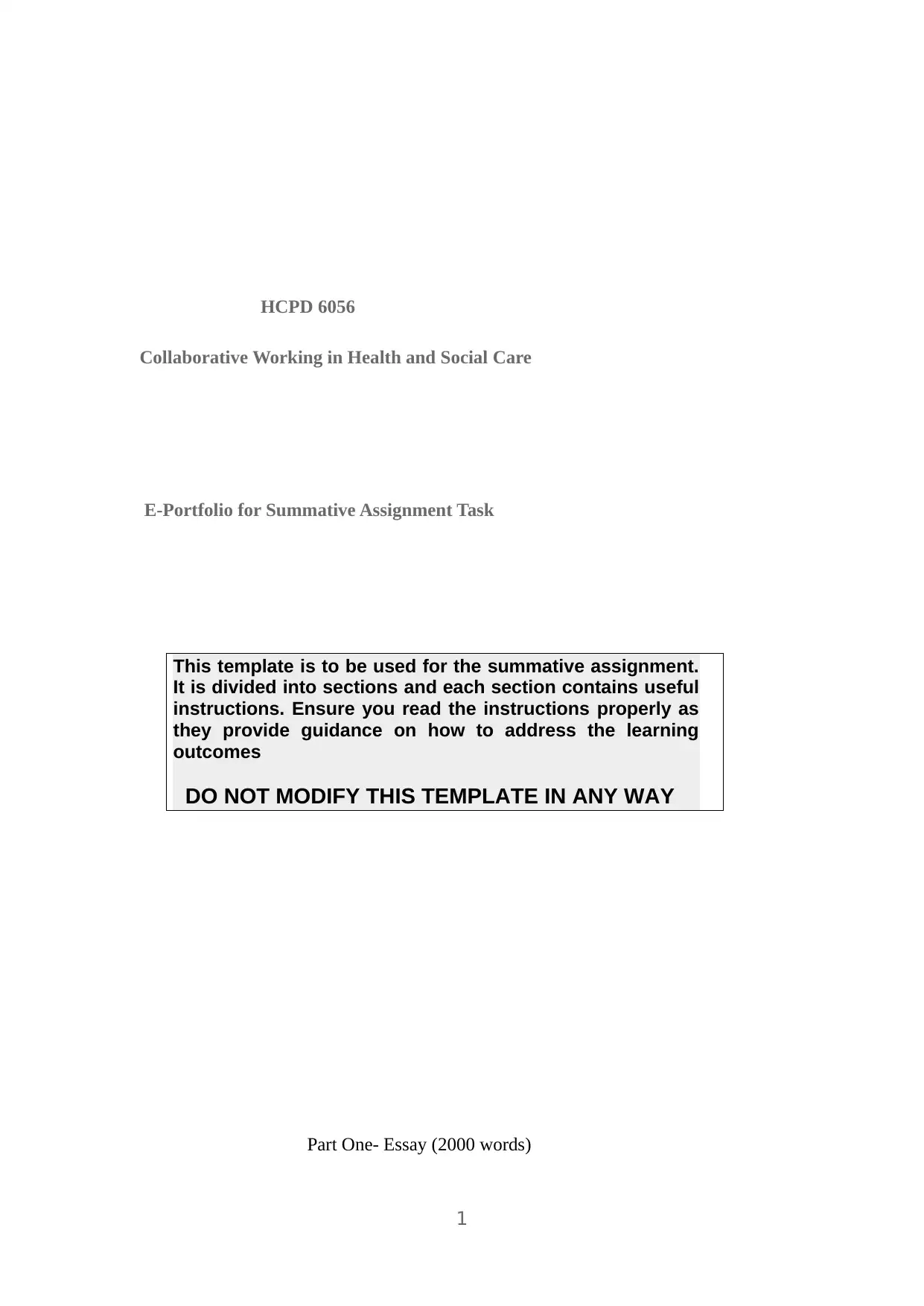
HCPD 6056
Collaborative Working in Health and Social Care
E-Portfolio for Summative Assignment Task
Part One- Essay (2000 words)
1
This template is to be used for the summative assignment.
It is divided into sections and each section contains useful
instructions. Ensure you read the instructions properly as
they provide guidance on how to address the learning
outcomes
DO NOT MODIFY THIS TEMPLATE IN ANY WAY
Collaborative Working in Health and Social Care
E-Portfolio for Summative Assignment Task
Part One- Essay (2000 words)
1
This template is to be used for the summative assignment.
It is divided into sections and each section contains useful
instructions. Ensure you read the instructions properly as
they provide guidance on how to address the learning
outcomes
DO NOT MODIFY THIS TEMPLATE IN ANY WAY
Paraphrase This Document
Need a fresh take? Get an instant paraphrase of this document with our AI Paraphraser
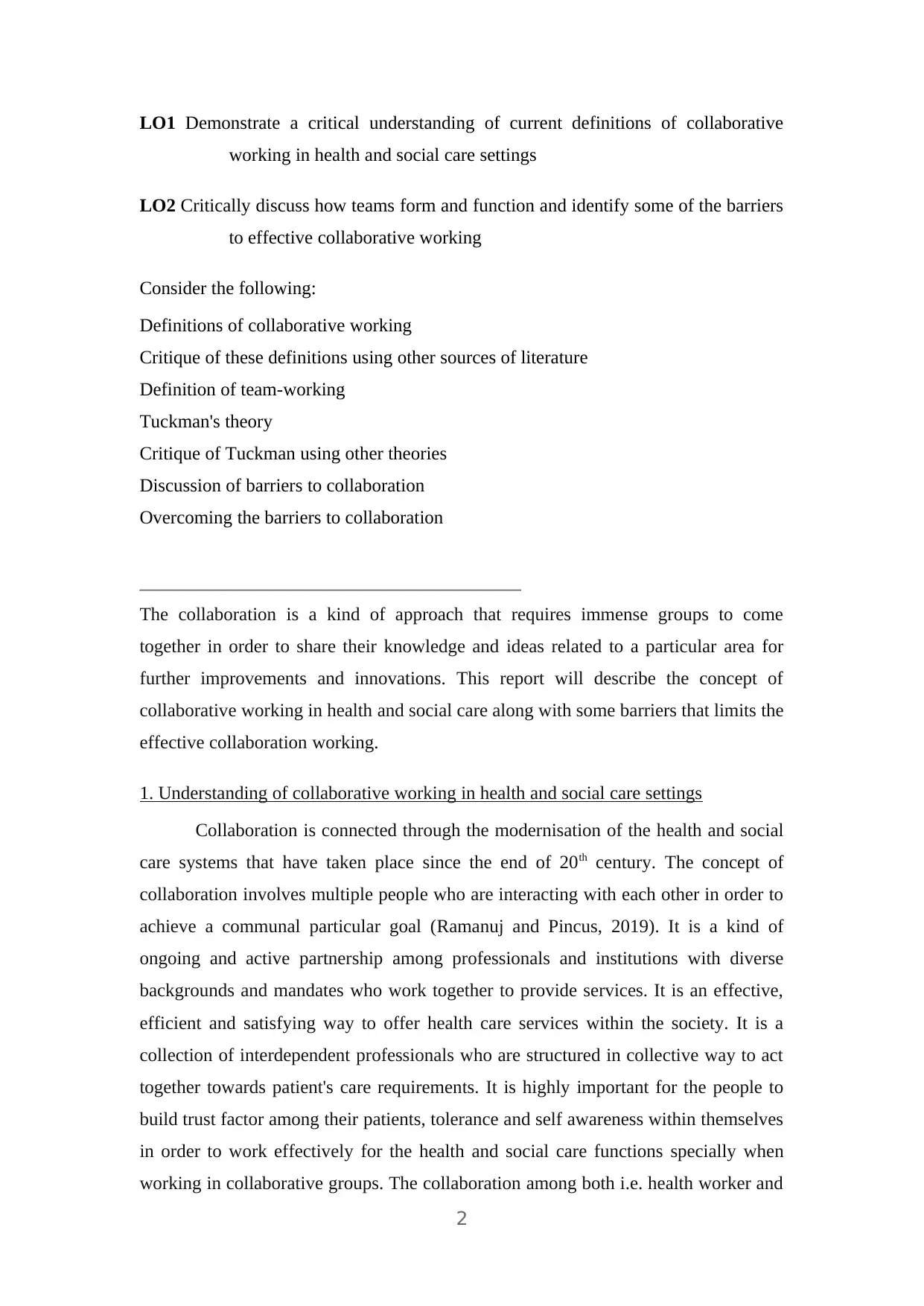
LO1 Demonstrate a critical understanding of current definitions of collaborative
working in health and social care settings
LO2 Critically discuss how teams form and function and identify some of the barriers
to effective collaborative working
Consider the following:
Definitions of collaborative working
Critique of these definitions using other sources of literature
Definition of team-working
Tuckman's theory
Critique of Tuckman using other theories
Discussion of barriers to collaboration
Overcoming the barriers to collaboration
_________________________________________
The collaboration is a kind of approach that requires immense groups to come
together in order to share their knowledge and ideas related to a particular area for
further improvements and innovations. This report will describe the concept of
collaborative working in health and social care along with some barriers that limits the
effective collaboration working.
1. Understanding of collaborative working in health and social care settings
Collaboration is connected through the modernisation of the health and social
care systems that have taken place since the end of 20th century. The concept of
collaboration involves multiple people who are interacting with each other in order to
achieve a communal particular goal (Ramanuj and Pincus, 2019). It is a kind of
ongoing and active partnership among professionals and institutions with diverse
backgrounds and mandates who work together to provide services. It is an effective,
efficient and satisfying way to offer health care services within the society. It is a
collection of interdependent professionals who are structured in collective way to act
together towards patient's care requirements. It is highly important for the people to
build trust factor among their patients, tolerance and self awareness within themselves
in order to work effectively for the health and social care functions specially when
working in collaborative groups. The collaboration among both i.e. health worker and
2
working in health and social care settings
LO2 Critically discuss how teams form and function and identify some of the barriers
to effective collaborative working
Consider the following:
Definitions of collaborative working
Critique of these definitions using other sources of literature
Definition of team-working
Tuckman's theory
Critique of Tuckman using other theories
Discussion of barriers to collaboration
Overcoming the barriers to collaboration
_________________________________________
The collaboration is a kind of approach that requires immense groups to come
together in order to share their knowledge and ideas related to a particular area for
further improvements and innovations. This report will describe the concept of
collaborative working in health and social care along with some barriers that limits the
effective collaboration working.
1. Understanding of collaborative working in health and social care settings
Collaboration is connected through the modernisation of the health and social
care systems that have taken place since the end of 20th century. The concept of
collaboration involves multiple people who are interacting with each other in order to
achieve a communal particular goal (Ramanuj and Pincus, 2019). It is a kind of
ongoing and active partnership among professionals and institutions with diverse
backgrounds and mandates who work together to provide services. It is an effective,
efficient and satisfying way to offer health care services within the society. It is a
collection of interdependent professionals who are structured in collective way to act
together towards patient's care requirements. It is highly important for the people to
build trust factor among their patients, tolerance and self awareness within themselves
in order to work effectively for the health and social care functions specially when
working in collaborative groups. The collaboration among both i.e. health worker and
2
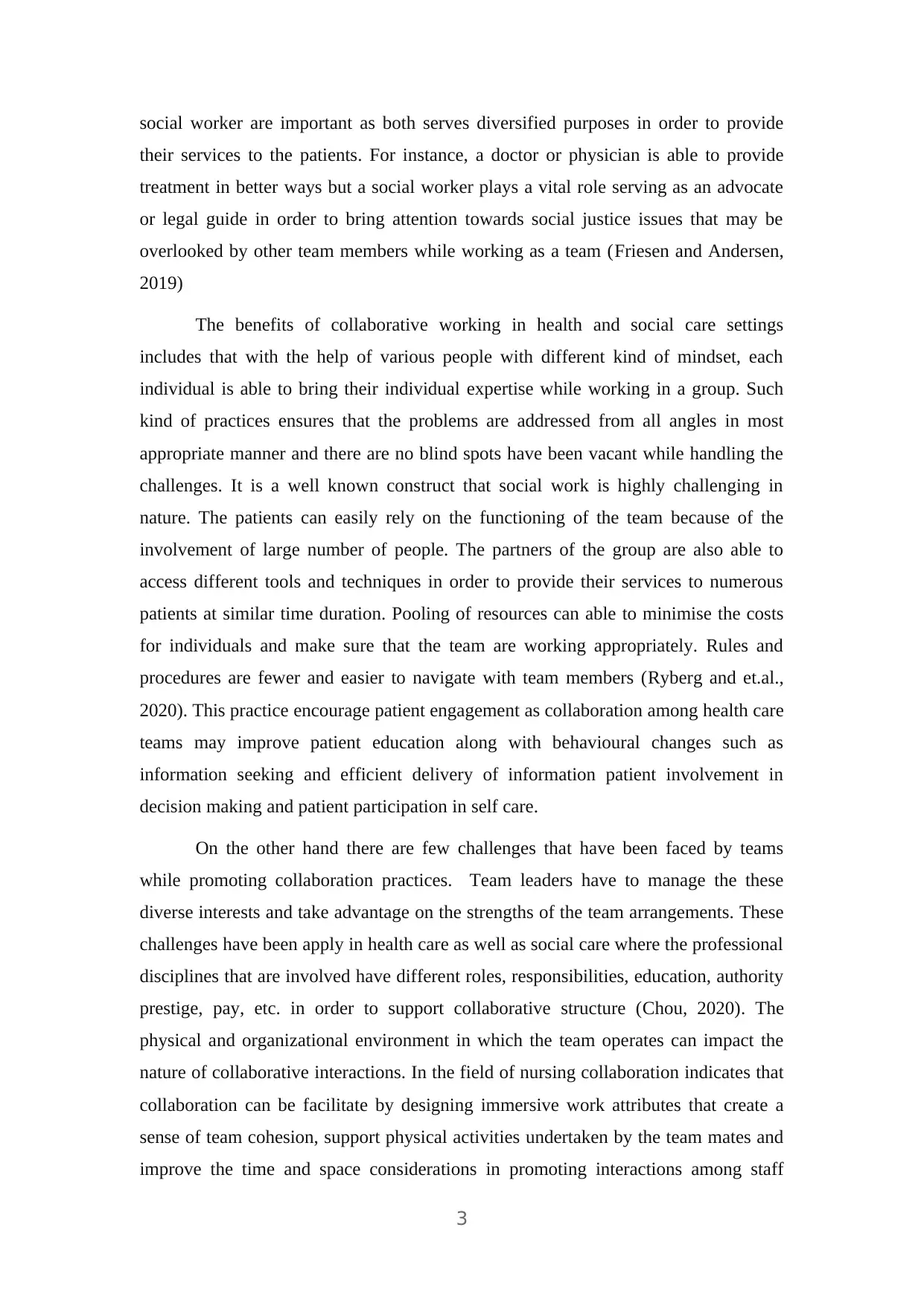
social worker are important as both serves diversified purposes in order to provide
their services to the patients. For instance, a doctor or physician is able to provide
treatment in better ways but a social worker plays a vital role serving as an advocate
or legal guide in order to bring attention towards social justice issues that may be
overlooked by other team members while working as a team (Friesen and Andersen,
2019)
The benefits of collaborative working in health and social care settings
includes that with the help of various people with different kind of mindset, each
individual is able to bring their individual expertise while working in a group. Such
kind of practices ensures that the problems are addressed from all angles in most
appropriate manner and there are no blind spots have been vacant while handling the
challenges. It is a well known construct that social work is highly challenging in
nature. The patients can easily rely on the functioning of the team because of the
involvement of large number of people. The partners of the group are also able to
access different tools and techniques in order to provide their services to numerous
patients at similar time duration. Pooling of resources can able to minimise the costs
for individuals and make sure that the team are working appropriately. Rules and
procedures are fewer and easier to navigate with team members (Ryberg and et.al.,
2020). This practice encourage patient engagement as collaboration among health care
teams may improve patient education along with behavioural changes such as
information seeking and efficient delivery of information patient involvement in
decision making and patient participation in self care.
On the other hand there are few challenges that have been faced by teams
while promoting collaboration practices. Team leaders have to manage the these
diverse interests and take advantage on the strengths of the team arrangements. These
challenges have been apply in health care as well as social care where the professional
disciplines that are involved have different roles, responsibilities, education, authority
prestige, pay, etc. in order to support collaborative structure (Chou, 2020). The
physical and organizational environment in which the team operates can impact the
nature of collaborative interactions. In the field of nursing collaboration indicates that
collaboration can be facilitate by designing immersive work attributes that create a
sense of team cohesion, support physical activities undertaken by the team mates and
improve the time and space considerations in promoting interactions among staff
3
their services to the patients. For instance, a doctor or physician is able to provide
treatment in better ways but a social worker plays a vital role serving as an advocate
or legal guide in order to bring attention towards social justice issues that may be
overlooked by other team members while working as a team (Friesen and Andersen,
2019)
The benefits of collaborative working in health and social care settings
includes that with the help of various people with different kind of mindset, each
individual is able to bring their individual expertise while working in a group. Such
kind of practices ensures that the problems are addressed from all angles in most
appropriate manner and there are no blind spots have been vacant while handling the
challenges. It is a well known construct that social work is highly challenging in
nature. The patients can easily rely on the functioning of the team because of the
involvement of large number of people. The partners of the group are also able to
access different tools and techniques in order to provide their services to numerous
patients at similar time duration. Pooling of resources can able to minimise the costs
for individuals and make sure that the team are working appropriately. Rules and
procedures are fewer and easier to navigate with team members (Ryberg and et.al.,
2020). This practice encourage patient engagement as collaboration among health care
teams may improve patient education along with behavioural changes such as
information seeking and efficient delivery of information patient involvement in
decision making and patient participation in self care.
On the other hand there are few challenges that have been faced by teams
while promoting collaboration practices. Team leaders have to manage the these
diverse interests and take advantage on the strengths of the team arrangements. These
challenges have been apply in health care as well as social care where the professional
disciplines that are involved have different roles, responsibilities, education, authority
prestige, pay, etc. in order to support collaborative structure (Chou, 2020). The
physical and organizational environment in which the team operates can impact the
nature of collaborative interactions. In the field of nursing collaboration indicates that
collaboration can be facilitate by designing immersive work attributes that create a
sense of team cohesion, support physical activities undertaken by the team mates and
improve the time and space considerations in promoting interactions among staff
3
⊘ This is a preview!⊘
Do you want full access?
Subscribe today to unlock all pages.

Trusted by 1+ million students worldwide

members. In order to do successful collaborations within social and healthcare
settings there are certain factors that limits the advantages of doing it in terms of
fulfilling the tasks or providing services to the patients. It includes personalities of
different people are diverse in nature, feeling of competitiveness among the partners
of the team, lack of information along with experiences, lack of resources specifically
at the time of taking decisions, cultural mismatch, lack of consistency and clarity of
roles and responsibilities, etc. (Chambers and Schmid, 2019).
In order to overcome from such kind of challenges, the collaborative teams
have to foster a climate that encourages partnership while working with external
practitioners or other people within a group. Creation of balance in collaborative
relationships are highly recommended as the excessive emerging can be unproductive
in nature. Apart from this, the situation under which the collaboration has been
utilised is also become a part of major concern although collaboration is best utilised
in order to resolve issues related to imperfect, diversified and constantly changing
solutions (Restall and Egan, 2021). However, collaboration is not consistently good
nor pervasively beneficial nor it is always required in every situation. Thus, the
increasing complexity in health care and social care system along with patients
conditions, the number of problems faced by team members enhances the requirement
of collaboration within their efforts.
2. The ways in which teams form and function in collaborative manner along with
certain barriers to effective collaborative working
It has been understood from above description that collaborative working is
extremely important and valuable in order to fulfil various ways. This leads towards
the question that the ways in which one can able to create and support collaborative
teams. Even after changes within the organizational structures are enhanced their
focus on the collaboration of activities between professionals that are practising in
health care teams. The managers and decision makers implementing such
reorganizations that effectively encourage the development of collaborative
relationship within inter-professional teams. With the help of proper and common
vision and strategies, team are able to find clarity and directions as a united group that
values the diversity among the members (née Blackwell and et.al., 2017). Procedures
4
settings there are certain factors that limits the advantages of doing it in terms of
fulfilling the tasks or providing services to the patients. It includes personalities of
different people are diverse in nature, feeling of competitiveness among the partners
of the team, lack of information along with experiences, lack of resources specifically
at the time of taking decisions, cultural mismatch, lack of consistency and clarity of
roles and responsibilities, etc. (Chambers and Schmid, 2019).
In order to overcome from such kind of challenges, the collaborative teams
have to foster a climate that encourages partnership while working with external
practitioners or other people within a group. Creation of balance in collaborative
relationships are highly recommended as the excessive emerging can be unproductive
in nature. Apart from this, the situation under which the collaboration has been
utilised is also become a part of major concern although collaboration is best utilised
in order to resolve issues related to imperfect, diversified and constantly changing
solutions (Restall and Egan, 2021). However, collaboration is not consistently good
nor pervasively beneficial nor it is always required in every situation. Thus, the
increasing complexity in health care and social care system along with patients
conditions, the number of problems faced by team members enhances the requirement
of collaboration within their efforts.
2. The ways in which teams form and function in collaborative manner along with
certain barriers to effective collaborative working
It has been understood from above description that collaborative working is
extremely important and valuable in order to fulfil various ways. This leads towards
the question that the ways in which one can able to create and support collaborative
teams. Even after changes within the organizational structures are enhanced their
focus on the collaboration of activities between professionals that are practising in
health care teams. The managers and decision makers implementing such
reorganizations that effectively encourage the development of collaborative
relationship within inter-professional teams. With the help of proper and common
vision and strategies, team are able to find clarity and directions as a united group that
values the diversity among the members (née Blackwell and et.al., 2017). Procedures
4
Paraphrase This Document
Need a fresh take? Get an instant paraphrase of this document with our AI Paraphraser
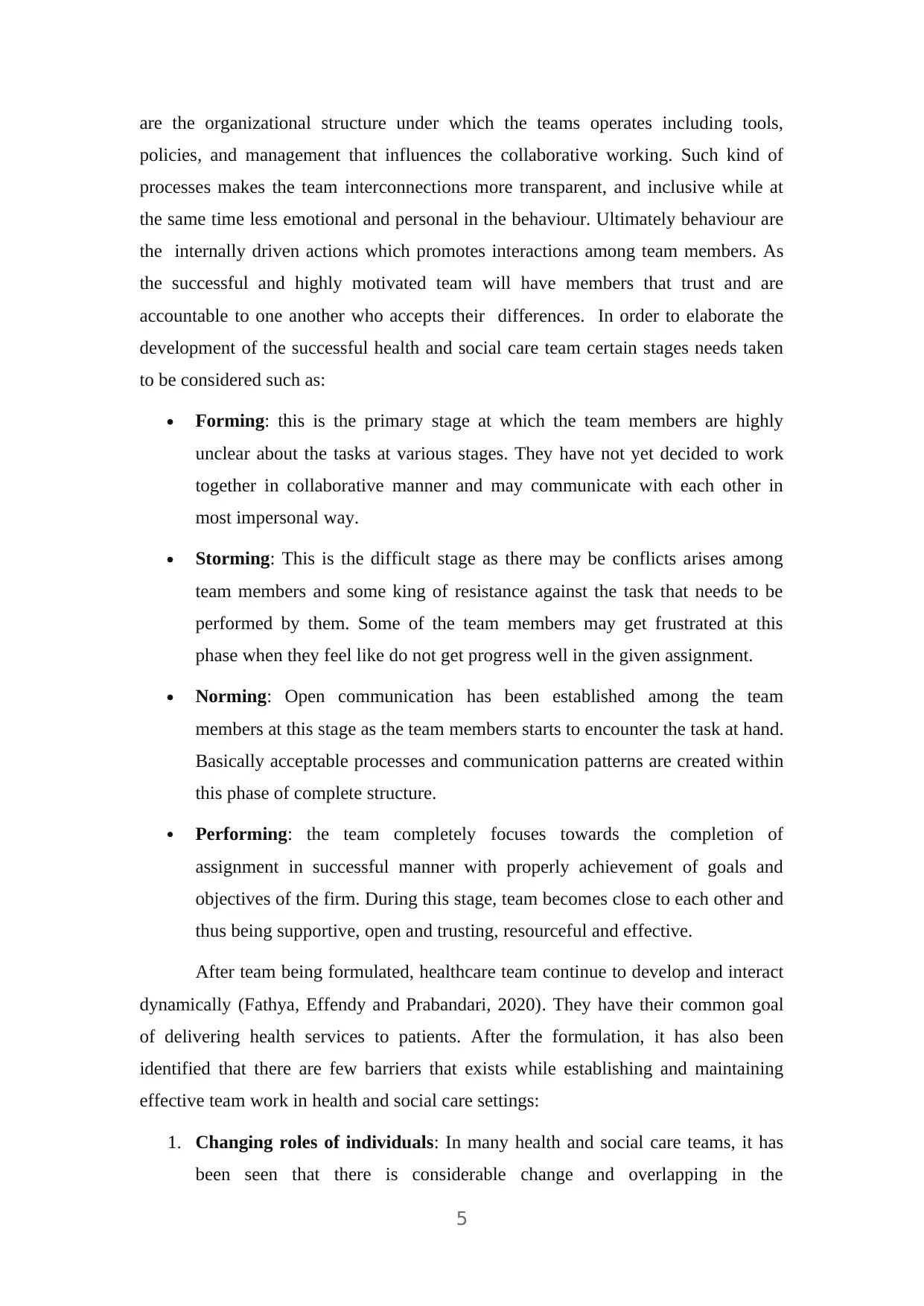
are the organizational structure under which the teams operates including tools,
policies, and management that influences the collaborative working. Such kind of
processes makes the team interconnections more transparent, and inclusive while at
the same time less emotional and personal in the behaviour. Ultimately behaviour are
the internally driven actions which promotes interactions among team members. As
the successful and highly motivated team will have members that trust and are
accountable to one another who accepts their differences. In order to elaborate the
development of the successful health and social care team certain stages needs taken
to be considered such as:
Forming: this is the primary stage at which the team members are highly
unclear about the tasks at various stages. They have not yet decided to work
together in collaborative manner and may communicate with each other in
most impersonal way.
Storming: This is the difficult stage as there may be conflicts arises among
team members and some king of resistance against the task that needs to be
performed by them. Some of the team members may get frustrated at this
phase when they feel like do not get progress well in the given assignment.
Norming: Open communication has been established among the team
members at this stage as the team members starts to encounter the task at hand.
Basically acceptable processes and communication patterns are created within
this phase of complete structure.
Performing: the team completely focuses towards the completion of
assignment in successful manner with properly achievement of goals and
objectives of the firm. During this stage, team becomes close to each other and
thus being supportive, open and trusting, resourceful and effective.
After team being formulated, healthcare team continue to develop and interact
dynamically (Fathya, Effendy and Prabandari, 2020). They have their common goal
of delivering health services to patients. After the formulation, it has also been
identified that there are few barriers that exists while establishing and maintaining
effective team work in health and social care settings:
1. Changing roles of individuals: In many health and social care teams, it has
been seen that there is considerable change and overlapping in the
5
policies, and management that influences the collaborative working. Such kind of
processes makes the team interconnections more transparent, and inclusive while at
the same time less emotional and personal in the behaviour. Ultimately behaviour are
the internally driven actions which promotes interactions among team members. As
the successful and highly motivated team will have members that trust and are
accountable to one another who accepts their differences. In order to elaborate the
development of the successful health and social care team certain stages needs taken
to be considered such as:
Forming: this is the primary stage at which the team members are highly
unclear about the tasks at various stages. They have not yet decided to work
together in collaborative manner and may communicate with each other in
most impersonal way.
Storming: This is the difficult stage as there may be conflicts arises among
team members and some king of resistance against the task that needs to be
performed by them. Some of the team members may get frustrated at this
phase when they feel like do not get progress well in the given assignment.
Norming: Open communication has been established among the team
members at this stage as the team members starts to encounter the task at hand.
Basically acceptable processes and communication patterns are created within
this phase of complete structure.
Performing: the team completely focuses towards the completion of
assignment in successful manner with properly achievement of goals and
objectives of the firm. During this stage, team becomes close to each other and
thus being supportive, open and trusting, resourceful and effective.
After team being formulated, healthcare team continue to develop and interact
dynamically (Fathya, Effendy and Prabandari, 2020). They have their common goal
of delivering health services to patients. After the formulation, it has also been
identified that there are few barriers that exists while establishing and maintaining
effective team work in health and social care settings:
1. Changing roles of individuals: In many health and social care teams, it has
been seen that there is considerable change and overlapping in the
5
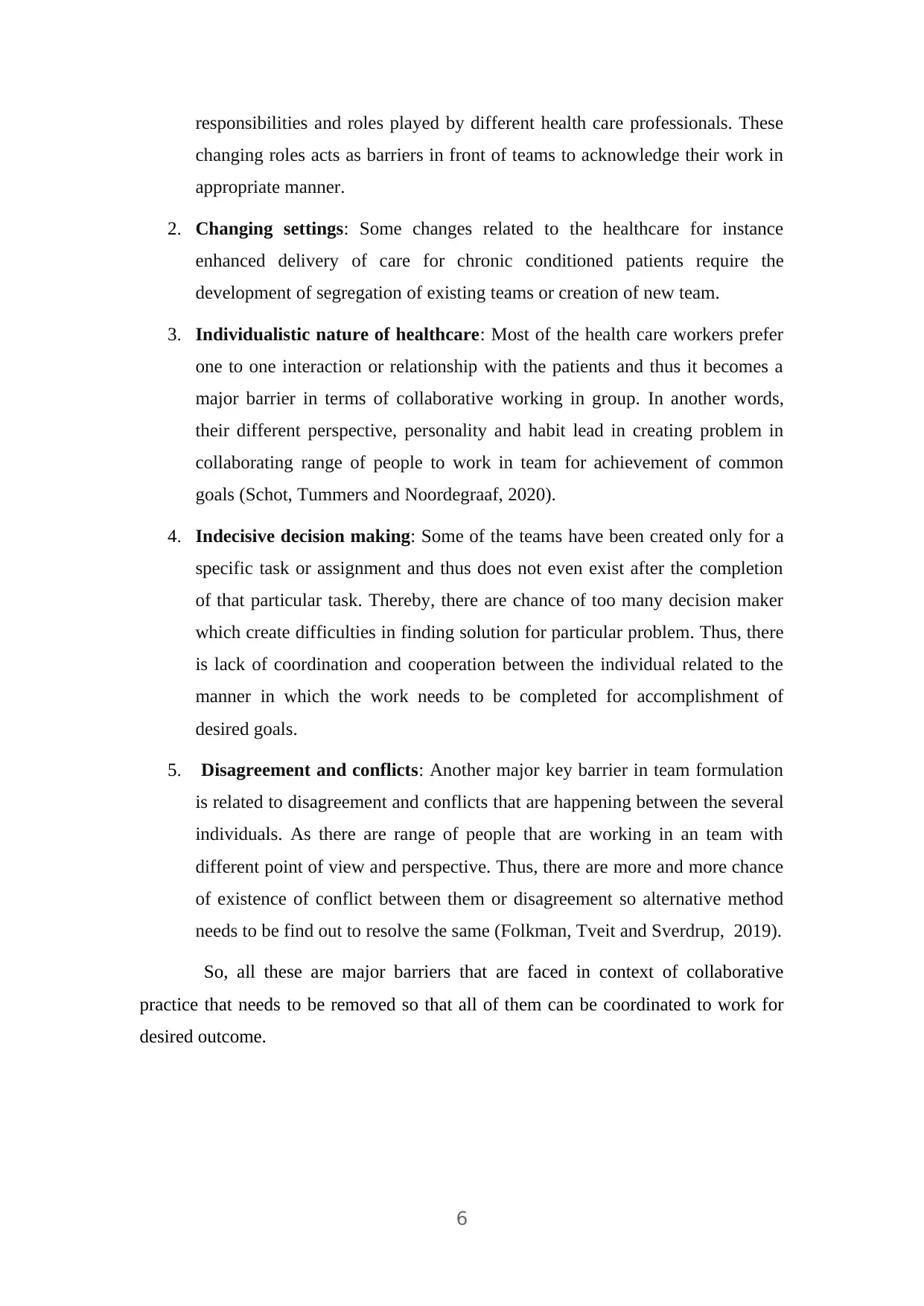
responsibilities and roles played by different health care professionals. These
changing roles acts as barriers in front of teams to acknowledge their work in
appropriate manner.
2. Changing settings: Some changes related to the healthcare for instance
enhanced delivery of care for chronic conditioned patients require the
development of segregation of existing teams or creation of new team.
3. Individualistic nature of healthcare: Most of the health care workers prefer
one to one interaction or relationship with the patients and thus it becomes a
major barrier in terms of collaborative working in group. In another words,
their different perspective, personality and habit lead in creating problem in
collaborating range of people to work in team for achievement of common
goals (Schot, Tummers and Noordegraaf, 2020).
4. Indecisive decision making: Some of the teams have been created only for a
specific task or assignment and thus does not even exist after the completion
of that particular task. Thereby, there are chance of too many decision maker
which create difficulties in finding solution for particular problem. Thus, there
is lack of coordination and cooperation between the individual related to the
manner in which the work needs to be completed for accomplishment of
desired goals.
5. Disagreement and conflicts: Another major key barrier in team formulation
is related to disagreement and conflicts that are happening between the several
individuals. As there are range of people that are working in an team with
different point of view and perspective. Thus, there are more and more chance
of existence of conflict between them or disagreement so alternative method
needs to be find out to resolve the same (Folkman, Tveit and Sverdrup, 2019).
So, all these are major barriers that are faced in context of collaborative
practice that needs to be removed so that all of them can be coordinated to work for
desired outcome.
6
changing roles acts as barriers in front of teams to acknowledge their work in
appropriate manner.
2. Changing settings: Some changes related to the healthcare for instance
enhanced delivery of care for chronic conditioned patients require the
development of segregation of existing teams or creation of new team.
3. Individualistic nature of healthcare: Most of the health care workers prefer
one to one interaction or relationship with the patients and thus it becomes a
major barrier in terms of collaborative working in group. In another words,
their different perspective, personality and habit lead in creating problem in
collaborating range of people to work in team for achievement of common
goals (Schot, Tummers and Noordegraaf, 2020).
4. Indecisive decision making: Some of the teams have been created only for a
specific task or assignment and thus does not even exist after the completion
of that particular task. Thereby, there are chance of too many decision maker
which create difficulties in finding solution for particular problem. Thus, there
is lack of coordination and cooperation between the individual related to the
manner in which the work needs to be completed for accomplishment of
desired goals.
5. Disagreement and conflicts: Another major key barrier in team formulation
is related to disagreement and conflicts that are happening between the several
individuals. As there are range of people that are working in an team with
different point of view and perspective. Thus, there are more and more chance
of existence of conflict between them or disagreement so alternative method
needs to be find out to resolve the same (Folkman, Tveit and Sverdrup, 2019).
So, all these are major barriers that are faced in context of collaborative
practice that needs to be removed so that all of them can be coordinated to work for
desired outcome.
6
⊘ This is a preview!⊘
Do you want full access?
Subscribe today to unlock all pages.

Trusted by 1+ million students worldwide
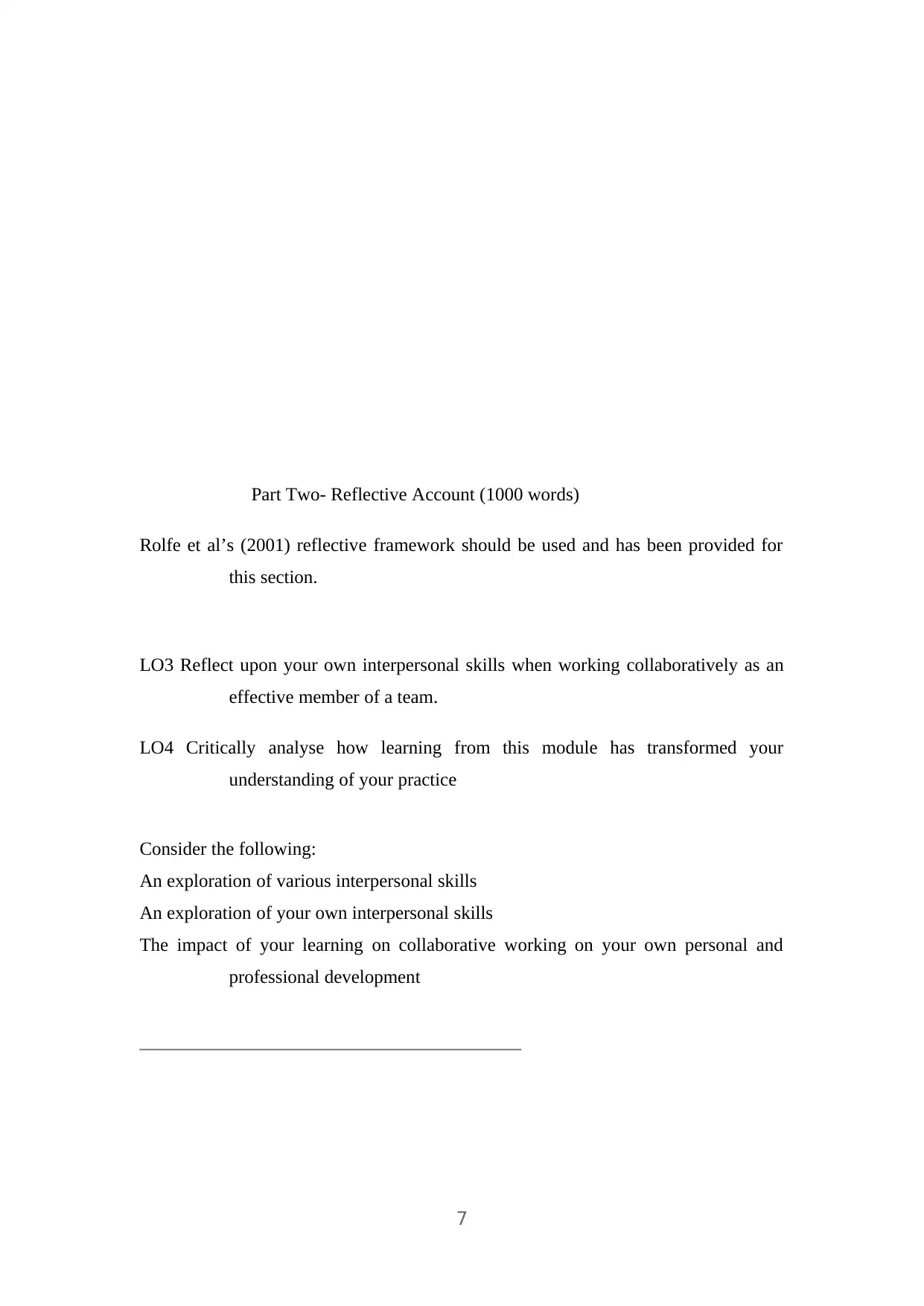
Part Two- Reflective Account (1000 words)
Rolfe et al’s (2001) reflective framework should be used and has been provided for
this section.
LO3 Reflect upon your own interpersonal skills when working collaboratively as an
effective member of a team.
LO4 Critically analyse how learning from this module has transformed your
understanding of your practice
Consider the following:
An exploration of various interpersonal skills
An exploration of your own interpersonal skills
The impact of your learning on collaborative working on your own personal and
professional development
_________________________________________
7
Rolfe et al’s (2001) reflective framework should be used and has been provided for
this section.
LO3 Reflect upon your own interpersonal skills when working collaboratively as an
effective member of a team.
LO4 Critically analyse how learning from this module has transformed your
understanding of your practice
Consider the following:
An exploration of various interpersonal skills
An exploration of your own interpersonal skills
The impact of your learning on collaborative working on your own personal and
professional development
_________________________________________
7
Paraphrase This Document
Need a fresh take? Get an instant paraphrase of this document with our AI Paraphraser
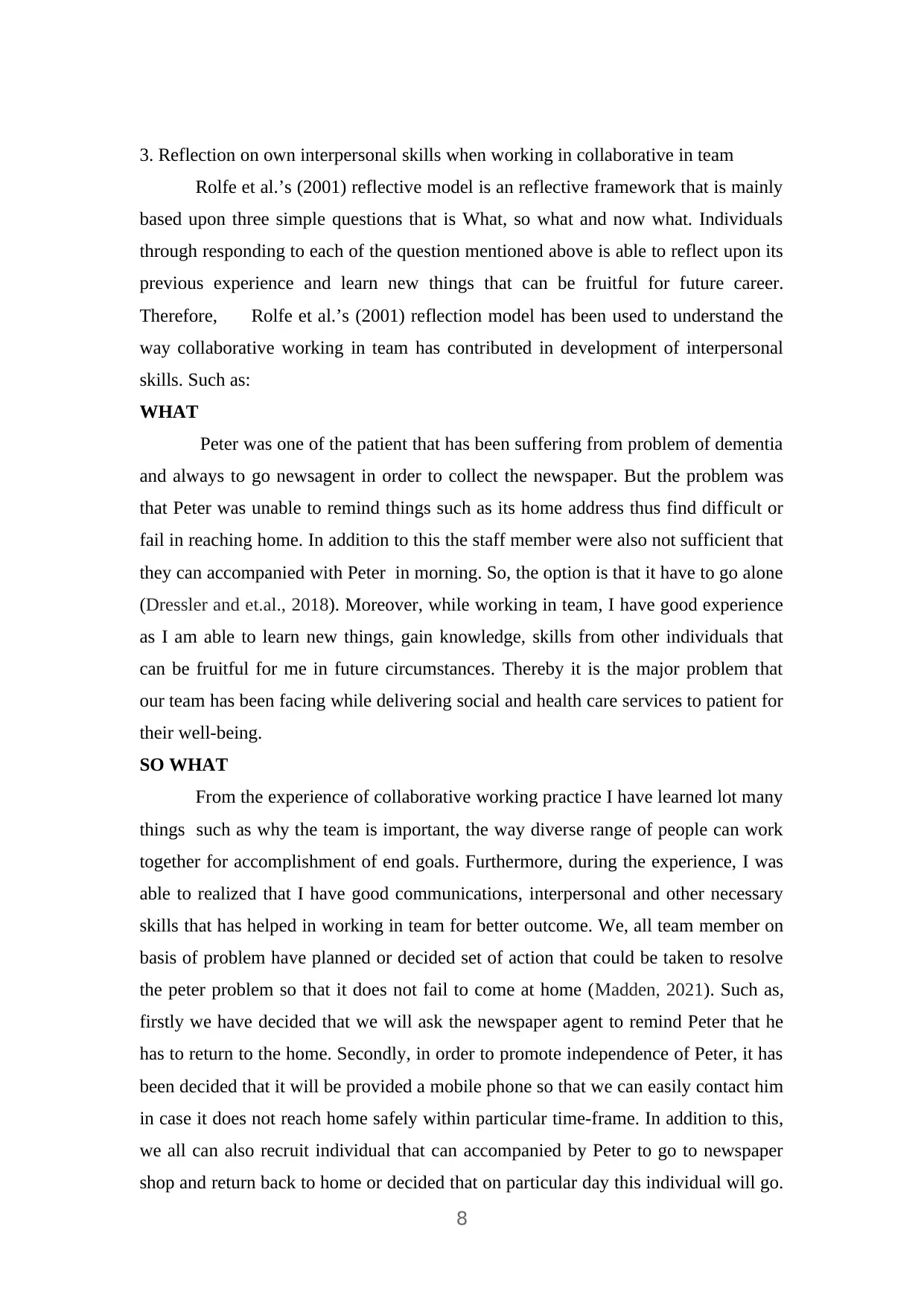
3. Reflection on own interpersonal skills when working in collaborative in team
Rolfe et al.’s (2001) reflective model is an reflective framework that is mainly
based upon three simple questions that is What, so what and now what. Individuals
through responding to each of the question mentioned above is able to reflect upon its
previous experience and learn new things that can be fruitful for future career.
Therefore, Rolfe et al.’s (2001) reflection model has been used to understand the
way collaborative working in team has contributed in development of interpersonal
skills. Such as:
WHAT
Peter was one of the patient that has been suffering from problem of dementia
and always to go newsagent in order to collect the newspaper. But the problem was
that Peter was unable to remind things such as its home address thus find difficult or
fail in reaching home. In addition to this the staff member were also not sufficient that
they can accompanied with Peter in morning. So, the option is that it have to go alone
(Dressler and et.al., 2018). Moreover, while working in team, I have good experience
as I am able to learn new things, gain knowledge, skills from other individuals that
can be fruitful for me in future circumstances. Thereby it is the major problem that
our team has been facing while delivering social and health care services to patient for
their well-being.
SO WHAT
From the experience of collaborative working practice I have learned lot many
things such as why the team is important, the way diverse range of people can work
together for accomplishment of end goals. Furthermore, during the experience, I was
able to realized that I have good communications, interpersonal and other necessary
skills that has helped in working in team for better outcome. We, all team member on
basis of problem have planned or decided set of action that could be taken to resolve
the peter problem so that it does not fail to come at home (Madden, 2021). Such as,
firstly we have decided that we will ask the newspaper agent to remind Peter that he
has to return to the home. Secondly, in order to promote independence of Peter, it has
been decided that it will be provided a mobile phone so that we can easily contact him
in case it does not reach home safely within particular time-frame. In addition to this,
we all can also recruit individual that can accompanied by Peter to go to newspaper
shop and return back to home or decided that on particular day this individual will go.
8
Rolfe et al.’s (2001) reflective model is an reflective framework that is mainly
based upon three simple questions that is What, so what and now what. Individuals
through responding to each of the question mentioned above is able to reflect upon its
previous experience and learn new things that can be fruitful for future career.
Therefore, Rolfe et al.’s (2001) reflection model has been used to understand the
way collaborative working in team has contributed in development of interpersonal
skills. Such as:
WHAT
Peter was one of the patient that has been suffering from problem of dementia
and always to go newsagent in order to collect the newspaper. But the problem was
that Peter was unable to remind things such as its home address thus find difficult or
fail in reaching home. In addition to this the staff member were also not sufficient that
they can accompanied with Peter in morning. So, the option is that it have to go alone
(Dressler and et.al., 2018). Moreover, while working in team, I have good experience
as I am able to learn new things, gain knowledge, skills from other individuals that
can be fruitful for me in future circumstances. Thereby it is the major problem that
our team has been facing while delivering social and health care services to patient for
their well-being.
SO WHAT
From the experience of collaborative working practice I have learned lot many
things such as why the team is important, the way diverse range of people can work
together for accomplishment of end goals. Furthermore, during the experience, I was
able to realized that I have good communications, interpersonal and other necessary
skills that has helped in working in team for better outcome. We, all team member on
basis of problem have planned or decided set of action that could be taken to resolve
the peter problem so that it does not fail to come at home (Madden, 2021). Such as,
firstly we have decided that we will ask the newspaper agent to remind Peter that he
has to return to the home. Secondly, in order to promote independence of Peter, it has
been decided that it will be provided a mobile phone so that we can easily contact him
in case it does not reach home safely within particular time-frame. In addition to this,
we all can also recruit individual that can accompanied by Peter to go to newspaper
shop and return back to home or decided that on particular day this individual will go.
8
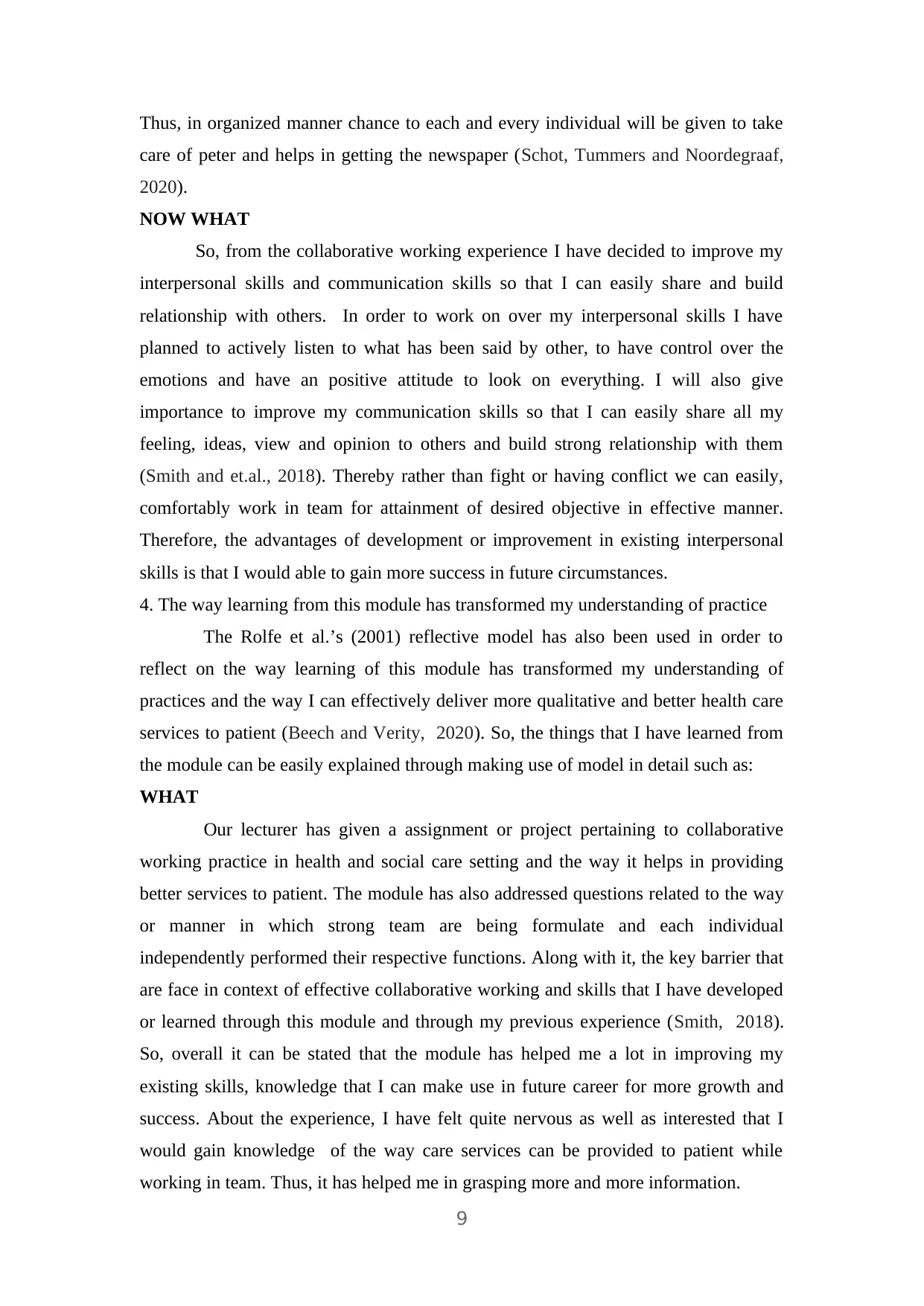
Thus, in organized manner chance to each and every individual will be given to take
care of peter and helps in getting the newspaper (Schot, Tummers and Noordegraaf,
2020).
NOW WHAT
So, from the collaborative working experience I have decided to improve my
interpersonal skills and communication skills so that I can easily share and build
relationship with others. In order to work on over my interpersonal skills I have
planned to actively listen to what has been said by other, to have control over the
emotions and have an positive attitude to look on everything. I will also give
importance to improve my communication skills so that I can easily share all my
feeling, ideas, view and opinion to others and build strong relationship with them
(Smith and et.al., 2018). Thereby rather than fight or having conflict we can easily,
comfortably work in team for attainment of desired objective in effective manner.
Therefore, the advantages of development or improvement in existing interpersonal
skills is that I would able to gain more success in future circumstances.
4. The way learning from this module has transformed my understanding of practice
The Rolfe et al.’s (2001) reflective model has also been used in order to
reflect on the way learning of this module has transformed my understanding of
practices and the way I can effectively deliver more qualitative and better health care
services to patient (Beech and Verity, 2020). So, the things that I have learned from
the module can be easily explained through making use of model in detail such as:
WHAT
Our lecturer has given a assignment or project pertaining to collaborative
working practice in health and social care setting and the way it helps in providing
better services to patient. The module has also addressed questions related to the way
or manner in which strong team are being formulate and each individual
independently performed their respective functions. Along with it, the key barrier that
are face in context of effective collaborative working and skills that I have developed
or learned through this module and through my previous experience (Smith, 2018).
So, overall it can be stated that the module has helped me a lot in improving my
existing skills, knowledge that I can make use in future career for more growth and
success. About the experience, I have felt quite nervous as well as interested that I
would gain knowledge of the way care services can be provided to patient while
working in team. Thus, it has helped me in grasping more and more information.
9
care of peter and helps in getting the newspaper (Schot, Tummers and Noordegraaf,
2020).
NOW WHAT
So, from the collaborative working experience I have decided to improve my
interpersonal skills and communication skills so that I can easily share and build
relationship with others. In order to work on over my interpersonal skills I have
planned to actively listen to what has been said by other, to have control over the
emotions and have an positive attitude to look on everything. I will also give
importance to improve my communication skills so that I can easily share all my
feeling, ideas, view and opinion to others and build strong relationship with them
(Smith and et.al., 2018). Thereby rather than fight or having conflict we can easily,
comfortably work in team for attainment of desired objective in effective manner.
Therefore, the advantages of development or improvement in existing interpersonal
skills is that I would able to gain more success in future circumstances.
4. The way learning from this module has transformed my understanding of practice
The Rolfe et al.’s (2001) reflective model has also been used in order to
reflect on the way learning of this module has transformed my understanding of
practices and the way I can effectively deliver more qualitative and better health care
services to patient (Beech and Verity, 2020). So, the things that I have learned from
the module can be easily explained through making use of model in detail such as:
WHAT
Our lecturer has given a assignment or project pertaining to collaborative
working practice in health and social care setting and the way it helps in providing
better services to patient. The module has also addressed questions related to the way
or manner in which strong team are being formulate and each individual
independently performed their respective functions. Along with it, the key barrier that
are face in context of effective collaborative working and skills that I have developed
or learned through this module and through my previous experience (Smith, 2018).
So, overall it can be stated that the module has helped me a lot in improving my
existing skills, knowledge that I can make use in future career for more growth and
success. About the experience, I have felt quite nervous as well as interested that I
would gain knowledge of the way care services can be provided to patient while
working in team. Thus, it has helped me in grasping more and more information.
9
⊘ This is a preview!⊘
Do you want full access?
Subscribe today to unlock all pages.

Trusted by 1+ million students worldwide

SO WHAT
Through the module I have learned that team work plays an crucial or
significant role in delivering healthcare services to patient. As through the module, I
was able to reflect on one of my previous experience of working in team in order to
solve problem face by Peter and the way we all have found alternative solution. So
that it can easily get the newspaper and reach back to the home safely and securely
(Folkman, Tveit and Sverdrup, 2019). I could have added more models and theories in
project to make it more interesting and easy to understand and interpret. It has helped
me in reviewing and evaluating my existing interpersonal skills thereby finding
alternative method that can be used by me to develop a strong and successful team.
NOW WHAT
From the learning of module, I have decided to enhance my capabilities to
work in team or diverse range of people so that we can achieve the common
objectives. Moreover, in future I have decided to work on my communication,
interpersonal and problem solving capabilities so that I can easily complete the task. I
will try to interact as well as build relationship with more and more people in order to
understand their key preferences, wants and motivate them to work in group rather
than individual for attainment of desired objectives (Bochatay and et.al., 2017). Open
communication will be promoted between the team member in health and social care
setting so that they all can be informed about their respective task and responsibilities.
Thus, it helps in eradicating the chance of conflict and confusion that exist between
the individual thereby helping in making a better team (Smith, 2018).
CONCLUSION
From the above report there are various crucial information that can be
summarized pertaining to collaborative working practices in health and social care
setting. Changing roles of individuals, changing settings, instability in teams and other
barriers are faced in context of team formulation. Moreover, it can be summarized that
the reflection has helped in effective segregating information related to problem that I
have face, what I have learned and the way it would be useful for me in future
circumstances. At last, it can be concluded that module and my previous experience
has helped me a lot in improving my capabilities, skills and knowledge that can be
useful for me while delivering health and social care services to patient.
10
Through the module I have learned that team work plays an crucial or
significant role in delivering healthcare services to patient. As through the module, I
was able to reflect on one of my previous experience of working in team in order to
solve problem face by Peter and the way we all have found alternative solution. So
that it can easily get the newspaper and reach back to the home safely and securely
(Folkman, Tveit and Sverdrup, 2019). I could have added more models and theories in
project to make it more interesting and easy to understand and interpret. It has helped
me in reviewing and evaluating my existing interpersonal skills thereby finding
alternative method that can be used by me to develop a strong and successful team.
NOW WHAT
From the learning of module, I have decided to enhance my capabilities to
work in team or diverse range of people so that we can achieve the common
objectives. Moreover, in future I have decided to work on my communication,
interpersonal and problem solving capabilities so that I can easily complete the task. I
will try to interact as well as build relationship with more and more people in order to
understand their key preferences, wants and motivate them to work in group rather
than individual for attainment of desired objectives (Bochatay and et.al., 2017). Open
communication will be promoted between the team member in health and social care
setting so that they all can be informed about their respective task and responsibilities.
Thus, it helps in eradicating the chance of conflict and confusion that exist between
the individual thereby helping in making a better team (Smith, 2018).
CONCLUSION
From the above report there are various crucial information that can be
summarized pertaining to collaborative working practices in health and social care
setting. Changing roles of individuals, changing settings, instability in teams and other
barriers are faced in context of team formulation. Moreover, it can be summarized that
the reflection has helped in effective segregating information related to problem that I
have face, what I have learned and the way it would be useful for me in future
circumstances. At last, it can be concluded that module and my previous experience
has helped me a lot in improving my capabilities, skills and knowledge that can be
useful for me while delivering health and social care services to patient.
10
Paraphrase This Document
Need a fresh take? Get an instant paraphrase of this document with our AI Paraphraser
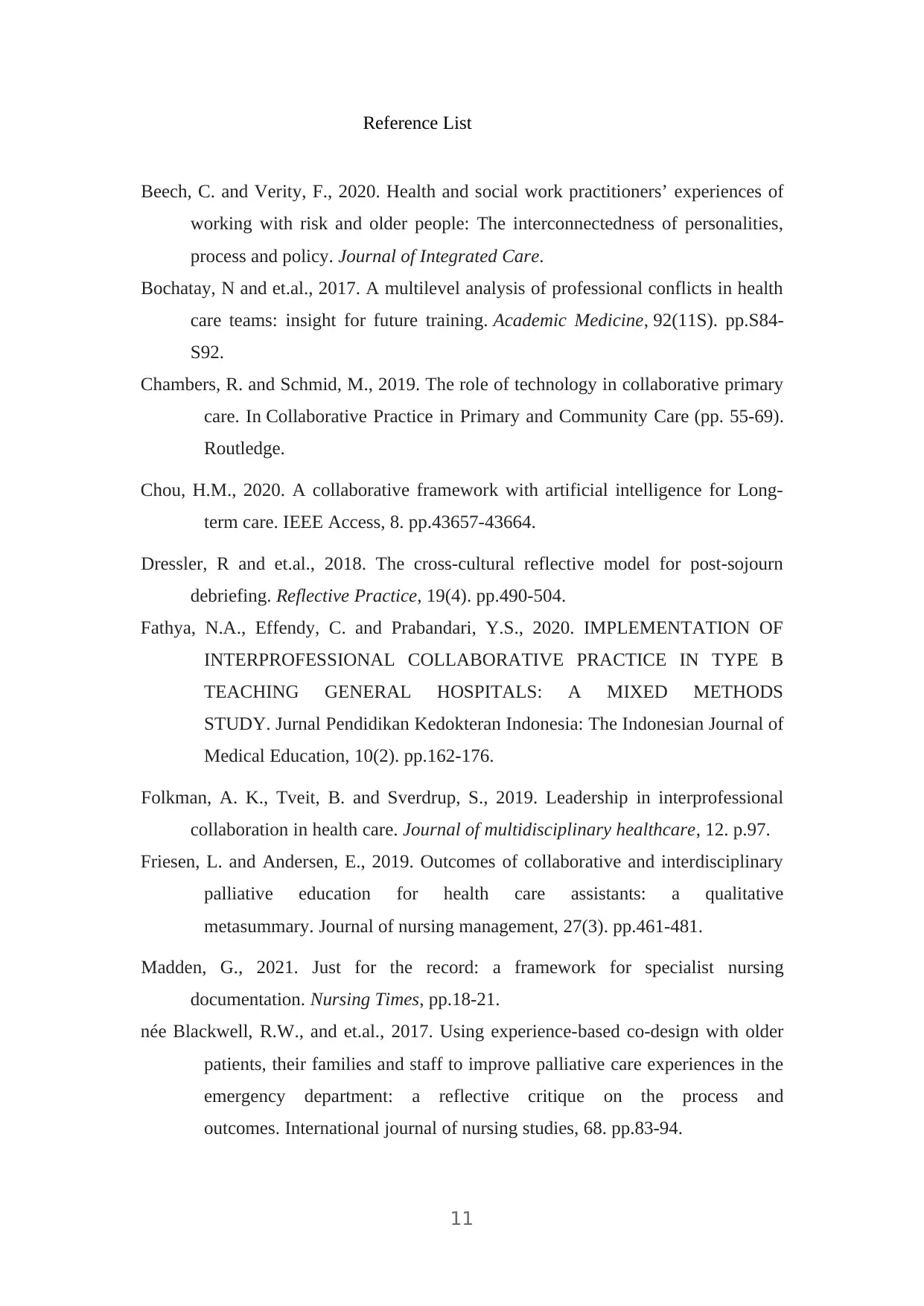
Reference List
Beech, C. and Verity, F., 2020. Health and social work practitioners’ experiences of
working with risk and older people: The interconnectedness of personalities,
process and policy. Journal of Integrated Care.
Bochatay, N and et.al., 2017. A multilevel analysis of professional conflicts in health
care teams: insight for future training. Academic Medicine, 92(11S). pp.S84-
S92.
Chambers, R. and Schmid, M., 2019. The role of technology in collaborative primary
care. In Collaborative Practice in Primary and Community Care (pp. 55-69).
Routledge.
Chou, H.M., 2020. A collaborative framework with artificial intelligence for Long-
term care. IEEE Access, 8. pp.43657-43664.
Dressler, R and et.al., 2018. The cross-cultural reflective model for post-sojourn
debriefing. Reflective Practice, 19(4). pp.490-504.
Fathya, N.A., Effendy, C. and Prabandari, Y.S., 2020. IMPLEMENTATION OF
INTERPROFESSIONAL COLLABORATIVE PRACTICE IN TYPE B
TEACHING GENERAL HOSPITALS: A MIXED METHODS
STUDY. Jurnal Pendidikan Kedokteran Indonesia: The Indonesian Journal of
Medical Education, 10(2). pp.162-176.
Folkman, A. K., Tveit, B. and Sverdrup, S., 2019. Leadership in interprofessional
collaboration in health care. Journal of multidisciplinary healthcare, 12. p.97.
Friesen, L. and Andersen, E., 2019. Outcomes of collaborative and interdisciplinary
palliative education for health care assistants: a qualitative
metasummary. Journal of nursing management, 27(3). pp.461-481.
Madden, G., 2021. Just for the record: a framework for specialist nursing
documentation. Nursing Times, pp.18-21.
née Blackwell, R.W., and et.al., 2017. Using experience-based co-design with older
patients, their families and staff to improve palliative care experiences in the
emergency department: a reflective critique on the process and
outcomes. International journal of nursing studies, 68. pp.83-94.
11
Beech, C. and Verity, F., 2020. Health and social work practitioners’ experiences of
working with risk and older people: The interconnectedness of personalities,
process and policy. Journal of Integrated Care.
Bochatay, N and et.al., 2017. A multilevel analysis of professional conflicts in health
care teams: insight for future training. Academic Medicine, 92(11S). pp.S84-
S92.
Chambers, R. and Schmid, M., 2019. The role of technology in collaborative primary
care. In Collaborative Practice in Primary and Community Care (pp. 55-69).
Routledge.
Chou, H.M., 2020. A collaborative framework with artificial intelligence for Long-
term care. IEEE Access, 8. pp.43657-43664.
Dressler, R and et.al., 2018. The cross-cultural reflective model for post-sojourn
debriefing. Reflective Practice, 19(4). pp.490-504.
Fathya, N.A., Effendy, C. and Prabandari, Y.S., 2020. IMPLEMENTATION OF
INTERPROFESSIONAL COLLABORATIVE PRACTICE IN TYPE B
TEACHING GENERAL HOSPITALS: A MIXED METHODS
STUDY. Jurnal Pendidikan Kedokteran Indonesia: The Indonesian Journal of
Medical Education, 10(2). pp.162-176.
Folkman, A. K., Tveit, B. and Sverdrup, S., 2019. Leadership in interprofessional
collaboration in health care. Journal of multidisciplinary healthcare, 12. p.97.
Friesen, L. and Andersen, E., 2019. Outcomes of collaborative and interdisciplinary
palliative education for health care assistants: a qualitative
metasummary. Journal of nursing management, 27(3). pp.461-481.
Madden, G., 2021. Just for the record: a framework for specialist nursing
documentation. Nursing Times, pp.18-21.
née Blackwell, R.W., and et.al., 2017. Using experience-based co-design with older
patients, their families and staff to improve palliative care experiences in the
emergency department: a reflective critique on the process and
outcomes. International journal of nursing studies, 68. pp.83-94.
11
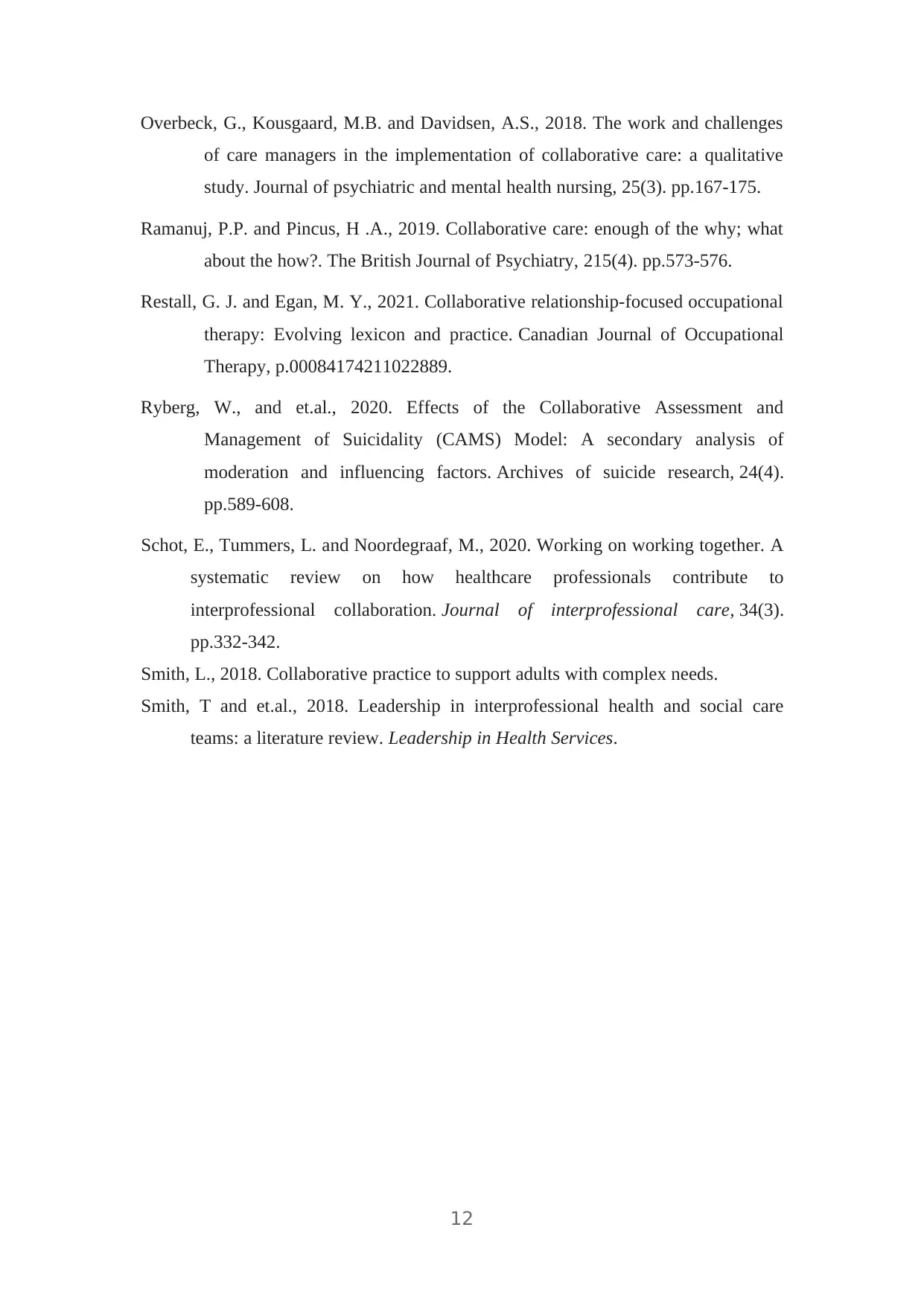
Overbeck, G., Kousgaard, M.B. and Davidsen, A.S., 2018. The work and challenges
of care managers in the implementation of collaborative care: a qualitative
study. Journal of psychiatric and mental health nursing, 25(3). pp.167-175.
Ramanuj, P.P. and Pincus, H .A., 2019. Collaborative care: enough of the why; what
about the how?. The British Journal of Psychiatry, 215(4). pp.573-576.
Restall, G. J. and Egan, M. Y., 2021. Collaborative relationship-focused occupational
therapy: Evolving lexicon and practice. Canadian Journal of Occupational
Therapy, p.00084174211022889.
Ryberg, W., and et.al., 2020. Effects of the Collaborative Assessment and
Management of Suicidality (CAMS) Model: A secondary analysis of
moderation and influencing factors. Archives of suicide research, 24(4).
pp.589-608.
Schot, E., Tummers, L. and Noordegraaf, M., 2020. Working on working together. A
systematic review on how healthcare professionals contribute to
interprofessional collaboration. Journal of interprofessional care, 34(3).
pp.332-342.
Smith, L., 2018. Collaborative practice to support adults with complex needs.
Smith, T and et.al., 2018. Leadership in interprofessional health and social care
teams: a literature review. Leadership in Health Services.
12
of care managers in the implementation of collaborative care: a qualitative
study. Journal of psychiatric and mental health nursing, 25(3). pp.167-175.
Ramanuj, P.P. and Pincus, H .A., 2019. Collaborative care: enough of the why; what
about the how?. The British Journal of Psychiatry, 215(4). pp.573-576.
Restall, G. J. and Egan, M. Y., 2021. Collaborative relationship-focused occupational
therapy: Evolving lexicon and practice. Canadian Journal of Occupational
Therapy, p.00084174211022889.
Ryberg, W., and et.al., 2020. Effects of the Collaborative Assessment and
Management of Suicidality (CAMS) Model: A secondary analysis of
moderation and influencing factors. Archives of suicide research, 24(4).
pp.589-608.
Schot, E., Tummers, L. and Noordegraaf, M., 2020. Working on working together. A
systematic review on how healthcare professionals contribute to
interprofessional collaboration. Journal of interprofessional care, 34(3).
pp.332-342.
Smith, L., 2018. Collaborative practice to support adults with complex needs.
Smith, T and et.al., 2018. Leadership in interprofessional health and social care
teams: a literature review. Leadership in Health Services.
12
⊘ This is a preview!⊘
Do you want full access?
Subscribe today to unlock all pages.

Trusted by 1+ million students worldwide
1 out of 13
Related Documents
Your All-in-One AI-Powered Toolkit for Academic Success.
+13062052269
info@desklib.com
Available 24*7 on WhatsApp / Email
![[object Object]](/_next/static/media/star-bottom.7253800d.svg)
Unlock your academic potential
Copyright © 2020–2026 A2Z Services. All Rights Reserved. Developed and managed by ZUCOL.





